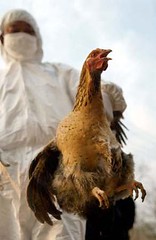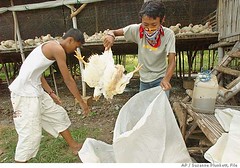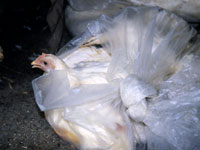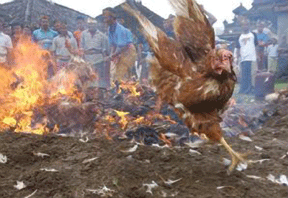Avian Influenza and 'The War on Birds', Part 2
Am I the only one who is stunned by the numbers of poultry that have been killed in an effort to control the spread of avian influenza in nine Asian countries during the past several years? Even though there is no official body count, the numbers of dead chickens, ducks, quails, geese and turkeys are estimated to range into the “hundreds of millions”. In 2003 alone, officials estimate that more than 120 million domestic birds either died from the dreaded avian influenza or were prophylactically killed to prevent further influenza spread throughout Asia. Personally, I have a difficult time thinking about this: I don’t know what 120 million birds look like, and further, I can’t imagine what 120 million of anything look like. (Perhaps an individual bird or human body contains 120 million molecules? I really don’t know).
How are so many birds killed in such a short period of time? Who kills them? What happens to the birds’ bodies after they are dead? Like most people, I had never really thought about these questions in much detail. In fact, I was researching two other avian influenza stories that I am writing when I stumbled across several shocking photographs yesterday (one of which I have been unable to locate today despite four hours of intensive searching). These pictures captured moments from some of the slaughters taking place in several Asian countries, moments that literally turned my stomach and pursued me into my sleep. In view of my familiarity with and long-time interest in influenza and birds, combined with my agrarian upbringing, I thought I could not be outraged or surprised by what I might discover as I investigated this story.
 How wrong I was. In short, after reading many dozens of news stories, government reports and journal articles published on the internet, it is disgustingly obvious to me that a panicked Asia has declared war on all birds and in doing so, has gouged a huge stinking swathe of needless, excessive cruelty through the populace that is paved with the corpses of hundreds millions of birds; wild and domestic; exotics and endemics; pets, “food animals” and migratory birds. But the worst atrocities are daily committed by those who routinely “cull” apparently healthy domestic poultry -- birds who had the tragic misfortune to live near a flock of poultry diagnosed with avian influenza.
How wrong I was. In short, after reading many dozens of news stories, government reports and journal articles published on the internet, it is disgustingly obvious to me that a panicked Asia has declared war on all birds and in doing so, has gouged a huge stinking swathe of needless, excessive cruelty through the populace that is paved with the corpses of hundreds millions of birds; wild and domestic; exotics and endemics; pets, “food animals” and migratory birds. But the worst atrocities are daily committed by those who routinely “cull” apparently healthy domestic poultry -- birds who had the tragic misfortune to live near a flock of poultry diagnosed with avian influenza.  So how, exactly, are these birds being killed? The methods vary but in Thailand, for example, many apparently healthy young birds are grabbed, groups of them are stuffed into plastic bags that are tied closed, and flung into large pits. The birds that survive such rough handling (most of them) are then buried. Alive. (The photograph shown here was originally accompanied by a caption that claimed these chickens were already dead. This clearly was the Associated Press story editor’s fantasy because the two birds in the man’s hand are looking around, as live birds do when suddenly upended. If they were dead, their necks, heads and wings would be dangling limply. They are not. Also notice the so-called “protective gear” worn by these Indonesian workers; a scarf tied over the nose and mouth. Click on the picture for a larger view in its own window. Photographer: Susanne Plunkett, AP).
So how, exactly, are these birds being killed? The methods vary but in Thailand, for example, many apparently healthy young birds are grabbed, groups of them are stuffed into plastic bags that are tied closed, and flung into large pits. The birds that survive such rough handling (most of them) are then buried. Alive. (The photograph shown here was originally accompanied by a caption that claimed these chickens were already dead. This clearly was the Associated Press story editor’s fantasy because the two birds in the man’s hand are looking around, as live birds do when suddenly upended. If they were dead, their necks, heads and wings would be dangling limply. They are not. Also notice the so-called “protective gear” worn by these Indonesian workers; a scarf tied over the nose and mouth. Click on the picture for a larger view in its own window. Photographer: Susanne Plunkett, AP).  “The slaughter of millions of chickens by burying them alive is an inhumane and totally unacceptable method of slaughter and should be stopped immediately,” says Leah Garces, the Head of Campaigns for the World Society for the Protection of Animals (WSPA). The WSPA is an international charity that actively promotes raising animal welfare standards through education and enforced legislation.
“The slaughter of millions of chickens by burying them alive is an inhumane and totally unacceptable method of slaughter and should be stopped immediately,” says Leah Garces, the Head of Campaigns for the World Society for the Protection of Animals (WSPA). The WSPA is an international charity that actively promotes raising animal welfare standards through education and enforced legislation. Another method of killing (or “culling” as many international health officials euphemistically describe it) apparently healthy young birds is to burn them. Alive. As you see in this picture, a chicken is running away from a bonfire -- obviously very alive.
 (Unfortunately, I was unable to locate another, much larger picture of a chicken that I saw yesterday. In that picture, the chicken was aflame and was attempting to escape from a bonfire. This makes me wonder; doesn’t anyone worry about possibly setting the village on fire that way?). Other birds are beaten with sticks, stomped to death or thrown into rivers -- the last action poses an obvious health hazard for anyone living downstream. Do any of these execution and disposal methods seem reasonable to you?
(Unfortunately, I was unable to locate another, much larger picture of a chicken that I saw yesterday. In that picture, the chicken was aflame and was attempting to escape from a bonfire. This makes me wonder; doesn’t anyone worry about possibly setting the village on fire that way?). Other birds are beaten with sticks, stomped to death or thrown into rivers -- the last action poses an obvious health hazard for anyone living downstream. Do any of these execution and disposal methods seem reasonable to you? “The appallingly rough treatment of these chickens, followed by their probable suffocation or death by heart attacks, or the effects of the lime thrown into the burial pits, is a welfare scandal,” said Joyce D’Silva, chief executive of Compassion in World Farming (CIWF). CIWF is an organization based in the United Kingdom that is dedicated to ending factory farming and long distance transport of animals.
Further, as you can see in some of these photographs linked here, the workers who carry out these massacres rarely wear protective clothing, thereby creating the possibility that they too, could become infected with avian influenza and thereby contribute to this growing public health crisis.
“Mass culling of animals always raises a conflict between speedy dispatch and humane slaughter methods,” D’Silva observes. Indeed, the evidence plainly shows that the massive poultry slaughter in Asia is poorly planned and is being executed with excessive and needless cruelty. For example, birds should only be killed under the supervision of a qualified veterinarian. Additionally, it should be absolutely unacceptable to allow untrained or inexperienced workers to slaughter these birds. Further, given the size of this influenza outbreak and its potential danger to the public health (and resulting public scrutiny), it is widely expected that officials will react quickly after a flock of birds has been diagnosed with influenza and that they will ensure that workers who kill the birds have appropriate protective clothing (and training).
It is imperative to avoid increasing the misery of these birds through cruel killing methods such packing them into sacks and burying them alive in pits, burning them alive or stomping/beating them to death. As unpleasant as it is to think about, it is possible to carry out the mass killing of farm animals in a humane way. For example, in 1997, Hong Kong humanely killed its entire poultry population in just three days. But this requires careful planning.
“There is no reason why animals must suffer unnecessarily as a result of this outbreak. More humane slaughter methods are available,” asserts Garces. One such humane method of killing animals is by exposing them to an inert gas, such as argon, which rapidly renders animals unconscious due to oxygen deprivation, which then quickly kills them. As an added benefit (if one can use this word in such a gruesome context), inert gases are easier to manage than other gases, such as carbon dioxide, and there is at least some evidence suggesting that inert gases do not cause birds to panic, as carbon dioxide does.
Mass killing of domestic poultry flocks also relies on compliance, but this is a significant problem. Because of poor financial reimbursement to chicken farmers for their losses by their governments, farmers hide their birds from officials or will sell them quickly if the birds appear healthy. This has led some officials to argue that a vaccination campaign should be enacted among poultry flocks that live near sick flocks to contain the virus. If the vaccinated birds have not been exposed to avian influenza, vaccination will prevent potential infection with the virus and could potentially save farmers from staggering financial losses, thereby increasing cooperation between farmers and officials.
“Culling infected flocks remains the recommended response when the disease is detected,” says Joseph Domenech, Chief of the Food and Agriculture Organization (FAO) of the United Nations’ Animal Health Service. Rapid killing of infected flocks reduces the chance that the virus can leave the farm or village by hitchhiking in live birds, or on human clothing, vehicles or baskets used to carry live birds to market.
“Vaccination, when used together with other control measures, such as market and movement management, and good agricultural practices, offers a suitable means to support the suppression of the further spread of the virus,” Domenech said.
In addition to rapid slaughter of inflected flocks, the UN advises two more key strategies for dealing with avian influenza: modernization of poultry farming and studies on how to detect outbreaks earlier, according to the UN’s FAO spokesman, Diderik de Vleeschauwer.
Modernizing poultry farming techniques should require farmers to be taught how to identify the most important routes by which avian influenza can gain access to their flocks and to assist them by providing necessary funding and materials to prevent that. Additionally, because the rapid growth of intensive farming practices are mirrored by the increased incidence of a plethora of “crowd diseases”, such as avian influenza, this means that development of livestock farming methods in the region must be examined very carefully. As part of this campaign, the WSPA is urging the World Health Organization and other public health agencies to avoid promoting or encouraging intensive farming practices anywhere in the world. These agencies instead advocate developing humane and sustainable farming practices, halting the expansion of factory farms and enacting a global ban on the use of antibiotics in animal feeds.
Factory farms are superb zoonotic disease “incubators” due to intense overcrowding, high stress levels, antibiotic abuse and poor hygienic practices. Additionally, impoverished Asian countries have few animal welfare, environmental and human health regulations and thus are extremely vulnerable to the excesses of factory farming methods, particularly to the development of increasingly lethal zoonotic infections that can jump species boundaries into humans and other animals. Clearly, this is an important situation that is crying out for an international re-evaluation of how livestock is raised and marketed.
========
Source material:
Bird Flu Crisis. Muzi Photo Gallery.
Concerns grow over animals buried alive in mass graves. World Society for the Protection of Animals (WSPA).
Asia Aims To Clip Bird Flu Spread, (Photos and story) CBS News.
New Initiative for Global Animal Welfare. Animal Welfare Institute.
The Need for Legislation and Elimination of Electrical Immobilization, by Karen Davis of United Poultry Concerns. (This is a fairly detailed comparison of slaughter methods for chickens, concluding that gassing is the most humane way to kill them).
Vaccination Campaign Could Help Stop Bird Flu. US Department of State report.
Vaccinating Birds May Help to Curtail Virus's Spread. Science Magazine.
My brain, which collects all sorts of information from the many (many!) papers, books and magazines that I read, from the scientists who tell me cool things, and from the superb university classes I've taken.
========
More Essays about Avian Influenza;
Avian Influenza and 'The War on Birds', Part 2.
Avian Influenza and 'The War on Birds'.
Influenza: How Its Biology Affects Vaccine Production.
Public Confusion Surrounding Influenza.
Is Avian Influenza THAT deadly?
© 2004, 2005, 2006 by GrrlScientist











9 Peer Reviews:
If you'd like to see what 100,000 pennies looks like go to:
http://www.kokogiak.com/megapenny/default.asp
Just scale the pennies to the size of a bird or scale to human to the size it would be if a bird were the size of a penny ...
Ben
Should have read 100,000,000. The site shows from 1 penny to 1 Quintillion pennies.
Ben
I can not understand why people act so cruelly to any other living thing. There are, as you write, so many other humane ways to carry out this horrible task.
Thanks for continuing to bring this to our attention. It is an important story that needs to be told.
This comment has been removed by a blog administrator.
This is what fear and lack of knowledge lead too. This panic as well as fear of economic disaster leads to crazy people doing crazy things. Common sense must go out the window.
I must remind you that - in your own words - you suspect that domestic chickens are not real birds!
G.
To play devil's advocate in a roundabout way, I have to wonder whether you (or anyone else who is horrified by such "barbaric" means of killing animals) had a rural upbringing or not. Rural areas have low incomes and don't have the money to throw about just to make sure that some oversensitive Westerners are kept happy. While I agree with you that better institutional mechanisms have to exist to reimburse farmers for their losses, and with a few other of your points, I don't really see the source of your general outrage.
G: Chickens may not be birds in an ornithological sense (well, in my ornithological sense) but they are living, sentient creatures who deserve to be treated better than this!
The Squire: You can play "devil's advocate" but I am still right to be outraged by this cruel behavior, and I have several good reasons for my outrage that go beyond the cruelty to the birds themselves (which, in my opinion, is a good enough reason to advocate strongly that the situation be handled differently).
First; cruelty to living things makes people more likely to accept cruelty and to behave in a cruel way towards other people. There is plenty of scientific evidence that shows this so I am not going to dig it all up and cite it here, but those are the facts. So, in short, socially acceptable cruelty to animals diminishes us all in a way that is unacceptable to society.
Second; there is a chance that, with all the blood and other body fluids saturated with the avian influenza virus flying around during the course of one of these er, "stomp-fests", that the human killers will inhale the virus and end up infected with it. Additionally, the virus can be spread around by hitchhiking on clothing and footwear. Yes, all those people wear special protective clothing and face masks to avoid infection/spread of this virus. So practically speaking, this is risky behavior that could help spread the virus to other birds and also to other animals, including people. This is what health officials are trying to avoid so if they can't do the job the right way, why bother doing anything at all?
I saw that same picture of a chicken in the middle of a flaming bonfire in a newsletter a few months back. It was a really powerful image - unfortunately, I can't find it anywhere now. Does anyone know the image I'm talking about ?
Post a Comment
<< Home